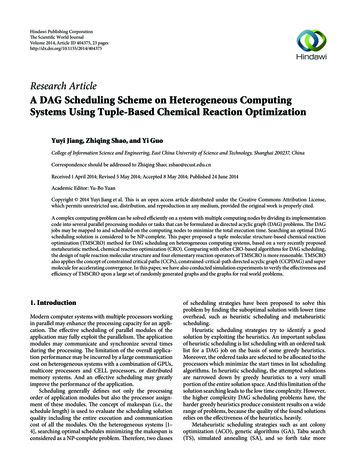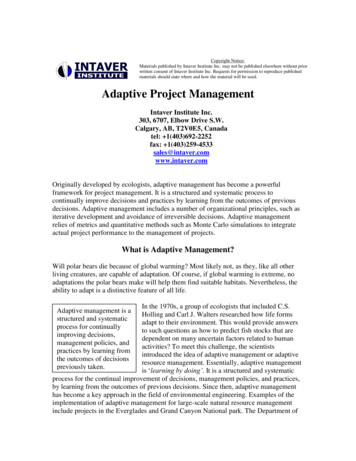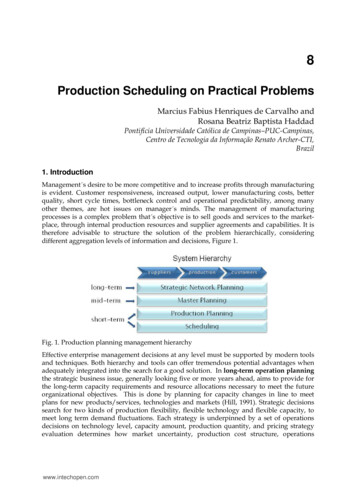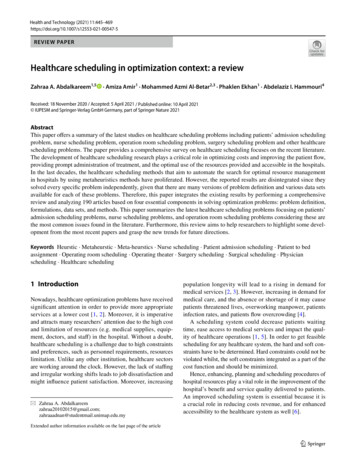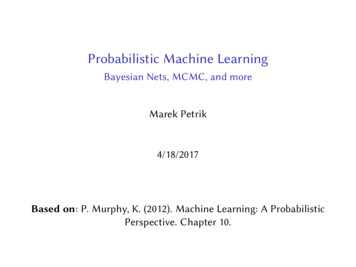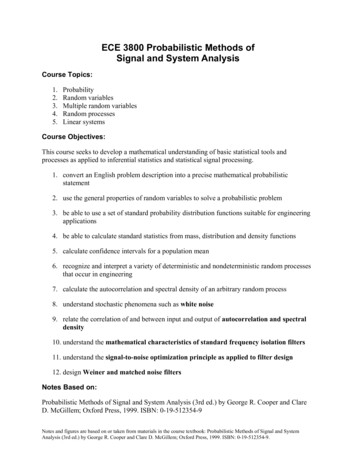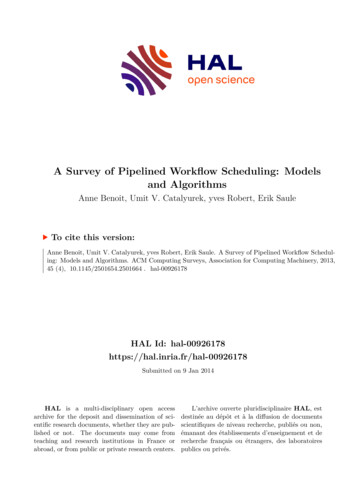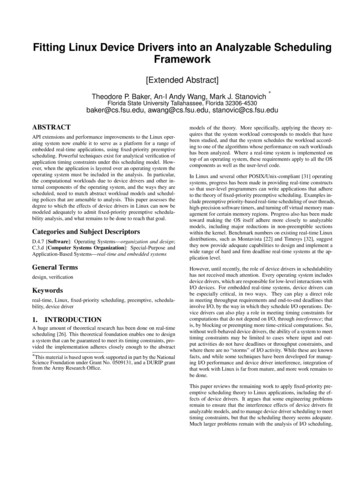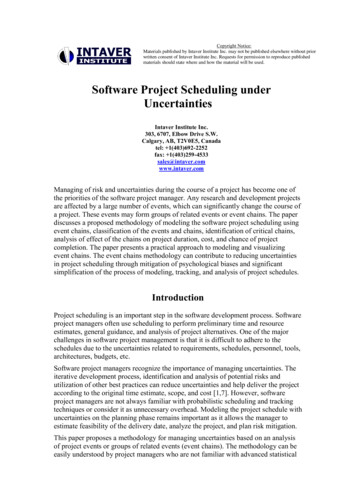
Transcription
Copyright Notice:Materials published by Intaver Institute Inc. may not be published elsewhere without priorwritten consent of Intaver Institute Inc. Requests for permission to reproduce publishedmaterials should state where and how the material will be used.Software Project Scheduling underUncertaintiesIntaver Institute Inc.303, 6707, Elbow Drive S.W.Calgary, AB, T2V0E5, Canadatel: 1(403)692-2252fax: ging of risk and uncertainties during the course of a project has become one ofthe priorities of the software project manager. Any research and development projectsare affected by a large number of events, which can significantly change the course ofa project. These events may form groups of related events or event chains. The paperdiscusses a proposed methodology of modeling the software project scheduling usingevent chains, classification of the events and chains, identification of critical chains,analysis of effect of the chains on project duration, cost, and chance of projectcompletion. The paper presents a practical approach to modeling and visualizingevent chains. The event chains methodology can contribute to reducing uncertaintiesin project scheduling through mitigation of psychological biases and significantsimplification of the process of modeling, tracking, and analysis of project schedules.IntroductionProject scheduling is an important step in the software development process. Softwareproject managers often use scheduling to perform preliminary time and resourceestimates, general guidance, and analysis of project alternatives. One of the majorchallenges in software project management is that it is difficult to adhere to theschedules due to the uncertainties related to requirements, schedules, personnel, tools,architectures, budgets, etc.Software project managers recognize the importance of managing uncertainties. Theiterative development process, identification and analysis of potential risks andutilization of other best practices can reduce uncertainties and help deliver the projectaccording to the original time estimate, scope, and cost [1,7]. However, softwareproject managers are not always familiar with probabilistic scheduling and trackingtechniques or consider it as unnecessary overhead. Modeling the project schedule withuncertainties on the planning phase remains important as it allows the manager toestimate feasibility of the delivery date, analyze the project, and plan risk mitigation.This paper proposes a methodology for managing uncertainties based on an analysisof project events or groups of related events (event chains). The methodology can beeasily understood by project managers who are not familiar with advanced statistical
theory. Managing uncertainties by the modeling of event chains is based on historicaldata, which leads to meaningful results. The software project scheduling using eventchains methodology can be easy adapted. The implementation of the methodologydoes not require additional project management resources. In addition, off-the-shelfsoftware tools that implement event chains methodology are available.Overview of Existing MethodologiesProject planning usually starts with the development of work breakdown structure(WBS). The WBS is a hierarchical set of independent tasks. As a part of WBS,development costs and duration of tasks need to be estimated. After defining the set oftasks, project managers define the precedence relationship that exists among tasks.This information can be presented in the form of precedence networks and Ganttcharts. The time needed to complete the project is defined by the longest path throughthe network. This path is called the critical path. Project managers can use the criticalpath method (CPM), which is available in most project management software, toidentify the critical path [4,8].In most cases, duration, start and finish time, cost, and other task parameters areuncertain. The PERT model (Program Evaluation and Review Technique) wasdeveloped in 1950s to address uncertainty in the estimation of project parameters.According to classic PERT, expected task duration is calculated as the weightedaverage of the most optimistic, the most pessimistic, and the most likely timeestimates. The expected duration of any path on the precedence network can be foundby summing up the expected durations. The main problem with classic PERT is that itgives accurate results only if there is a single dominant path through a precedencenetwork. When a single path is not dominant, classic PERT usually provides overlyoptimistic results [3].To overcome these challenges Monte Carlo simulations can be used as one of thealternatives. Monte Carlo simulations are a process that repeatedly sets values foreach random variable by sampling from each variable’s statistical distribution. Thevariables can be task duration, cost, start and finish time, etc. They are used tocalculate the critical path, slack values, etc. Monte Carlo simulations have beenproven an effective methodology for the analysis of project schedule withuncertainties. A number of software systems employ Monte Carlo simulations forprojects [6]. However, Monte Carlo simulation is rarely used in software projectmanagement because of two main reasons. First, most software systems require atleast some knowledge of statistics and risk analysis to define input data and interpretthe results of the analysis. Second, Monte Carlo simulations for software developmentdoes not provide accurate estimates of project parameters (duration, finish time, cost,etc.) due to the greater uncertainties related to requirements, tools, resources, budget,etc. compared to many other industries.Another approach to project scheduling with uncertainties was developed by Goldratt.Goldratt applied the theory of constraints (TOC) to project management [5,10]. Thecornerstone of TOC is resource constrained critical path called a critical chain.Goldratt’s approach is based on a deterministic critical path method. To deal withuncertainties, Goldratt suggests using project buffers and encourages early task
completion. Theory of constraints is well accepted in project management; however,the use of this approach in software development industry remains relatively low [4].Software Project Management with Heuristics and BiasesThe problem associated with all the aforementioned methodologies lies in theestimation of project input variables: task durations, start and finish times, cost,resources, etc. If input uncertainties are inaccurately estimated, it will lead toinaccurate results regardless of the methodology of project scheduling.Tversky and Kahneman [14] have proposed that limitations in human mentalprocesses cause people to employ various simplifying strategies to ease the burden ofmentally processing information to make judgments and decisions. During theplanning stage, software project managers rely on heuristics or rules of thumb to makeestimations. Under many circumstances heuristics lead to predictably faultyjudgments or cognitive biases.Following are short descriptions of some heuristics that affect the estimation ofproject variables for software project management.The availability heuristic [2,13] is a rule of thumb in which decision makers assess theprobability of an event by the ease with which instances or occurrences can bebrought to mind. For example, project managers sometimes estimate task durationbased on similar tasks that have been previously completed. If they are making theirjudgment based on their most or least successful tasks, it can cause inaccurateestimation.The anchoring heuristic [14] refers to the human tendency to remain close to theinitial estimate. For example, anchoring will lead to an overestimation of the successrate of the project with multiple phases because the chance of completion of eachseparate phase of the project can be an anchor in estimating the success rate for thewhole project [9].Judgments concerning the probability of a scenario are influenced by amount andnature of details in the scenario in a way that is unrelated to the actual likelihood ofthe scenario [12]. It is called the representativeness heuristic. This heuristic can leadto the “gambler’s fallacy” or belief that a positive event is overdue because a series ofnegative or undesirable events have already occurred.Decision makers can be exposed to many cognitive and motivational factors that canlead to biases in perceptions. This effect is often referred to as selective perception.For example, estimation of a task’s cost can be influenced by the intention to fit thetask into the project’s budget. As a result, some of the project parameters can beoverestimated.Plous [11] has made some general recommendations for mitigating the negativeimpact of these and other heuristics. It is very important to keep accurate records andmake estimations based on reliable historical data. Compound events should bebroken into smaller events, which have known probabilities of occurrence. Discussionof best- or worst-case scenarios, for example the estimation of the most optimistic, themost likely, and the most pessimistic durations in PERT, can lead to unintendedanchoring effects. To reduce dependence on motivational factors, Plous recommendsthe analysis of problems without taking expectations into account.
Overview of Event Chains MethodologyThe event chains methodology has been proposed to overcome difficulties associatedwith the estimation of project parameters, as well as to simplify the process of projectscheduling with uncertainties (schedule risk analysis) for software development.According to the traditional project management methodology, the task (activity) is acontinuous and uniform process. In reality, the task is affected by external events.These events can transform the task from one state to another. The state can bereferred to as a process or part of the process with constant properties.In most cases, especially for research and development projects such as softwaredevelopment, it is difficult to predict potential events at the stage of project planningand scheduling. Events can occur stochastically during the course of a task. One taskcan be affected many multiple probabilistic events defined by the event properties:chance of occurrence, probabilistic time of occurrence, and outcome (increaseduration or cost, cancel task, assign or remove resource, etc.). These events will beincluded to the task’s list of events. For example, during the course of development ofthe particular software feature, it may be discovered that the originally proposedsoftware architecture is not appropriate. This discovery event may cause thecancellation of the feature or even the project. It can also cause an increase in the taskduration and cost. The chance of occurrence of this event based on the previousexperience of development of similar tasks is 20%. Based on the same historical data,the event should occur during first two weeks of the development.In addition to probabilistic events, there are also conditional events. A conditionalevent will occur if some conditions, related to project variables, are met. For example,if the task has reached a deadline, the event “cancel task” can be generated. It ispossible to have a combined conditional probabilistic event. For example, if thedeadline is reached, there is 20% chance that the task will be canceled.The events can significantly affect the tasks, a group of tasks, and the whole project.Tasks within a group can have different relationships. It can be a summary task withsubtasks. A group may also include tasks with joint resources or other commonparameters, which can be affected by the same events. It is important to identifygroups of tasks in order to simplify the process of modeling with events.One event can lead to other events or create event chains. For example, an event ofarchitectural change in the software can require refactoring of the softwarecomponent. As a result, the resource will be pulled from another task, which willchange a state: a task will be delayed. Therefore, one event (architectural change) maycause a chain reaction and eventually lead to major change in schedule for the wholeproject. Event chains can be presented by an event chains diagram, as shown on Fig1.
Fig. 1. Example of event chains diagramFundamentally, calculations in event chains methodology are a variation of MonteCarlo simulations used in traditional risk analysis. During the simulation process,project input variables (cost, duration, start and finish time, chance of completion) foreach task will be calculated based on event properties. The result of calculation is astatistical distribution for the duration, start and finish time, success rate, and cost ofthe whole project or any separate task. The results can be represented in the form offrequency or cumulative probability plots. Statistical parameters for each outputvariable, including mean, variance, standard deviation, maximum and minimumvalues can also be calculated. They will be used to assess probability of completion ofthe project within a certain time and budget, as well as the probability ofimplementing a particular task (for example, features in a software developmentproject).All scheduling methods require making an initial estimate for the input projectvariables (task duration, start and finish time, etc.). Goldratt [5] recommends usingmedian for the task duration; Monte Carlo simulations [6] allow the project managerto define a statistical distribution. Because event chains methodology is based onMonte Carlo simulations, a project manager is able to specify statistical distributionsfor the input project variables. However, it is not recommended because if eventchains are defined, it can cause a double count of the same uncertainties. Instead,input parameters associated with focused work on activity or “best case scenario”should be defined. In addition, the project manager should define events and eventchains that can affect the project schedule. For example, the manager can estimatethat developing a particular feature will take from 5 to 8 days. Then the question thatshould be asked is, “What affects this duration?” It can be a number of potentialevents: requirement changes, unfamiliarity with development tools, uncleardefinitions of software architecture, hardware failure, etc. Lists of these events shouldbe assigned to the task. If everything goes well and no issues occur (focused work onactivity), the duration of the task will be 5 days.The probability of a task lying on the critical path (criticality index) used in classicMonte Carlo simulation [8] also can be calculated as a part of the methodology.However, sometimes it is very important to find out which events or event chainsaffect output project variables the most. It can be accomplished using sensitivityanalysis. These single events or event chains are called critical events or event chains.Results of sensitivity analysis can be presented in the form of sensitivity charts. Togenerate the sensitivity chart, correlation coefficients between output projectparameters and events or event chains must be calculated.One of the most important components of the event chains methodology is monitoringactual project performance and comparing it with original estimates. The schedulerisk analysis process must be repeated every time new results pertaining to the projector performance of each particular task have become available. Because events aretime-based, a new calculation will not include events that could have occurred prior tothe actual time. As a result, a new updated project forecast would be available basedon real project data.Event chains methodology is designed to mitigate negative impact of heuristicsrelated to estimation of project uncertainties:
1. The task duration, start and finish time, cost, and other project input parameters canbe influenced by motivational factors such as total project duration to much greaterextend than events and event chains. It happens because events cannot be easilytranslated into the duration, finish time, etc. Therefore, event chains methodologycan help to mitigate certain effects of selective perception in project management.2. The event chains methodology relies on estimation of duration based on focusedwork on activity and does not necessarily require low, base, and high estimation orstatistical distribution; therefore, the negative effect of anchoring can be mitigated.3. The probability of event can be easily calculated based on historical data. It helps tomitigate the effect of the availability heuristic. The probability equals the number oftimes an event actually occurred in previous projects divided by total number ofsituations when event could have occurred. In classic Monte Carlo simulations, thestatistical distribution of input parameters can also be obtained from the historicaldata; however, the procedure is more complicated and rarely used in practicalsoftware project management.4. The compound events can be easy broken into smaller events. Information aboutthese small events can be supported by reliable historical data. This mitigates theeffect of biases in estimation of probability and risk.Single EventsSingle events are the building blocks of the comprehensive probabilistic model of thesoftware development process.Each event has a number of properties. The events can affect the whole project, agroup of tasks, a particular task, or the resource. For example, if it is discovered that aselected software tool does not provide the required functionalities, all tasks that areusing this tool can be delayed.The following types of events are commonly used in the software developmentproject: Start and end tasks or group of tasks, Duration of a task or duration of each task within the group can be increased orreduced, Costs associated with a task or group of tasks can be increased (reduced), Tasks or each task within a group can be canceled, Resources can be reassigned or a new resource can be assigned, and Whole projects can be canceled.A new task duration or cost can be calculated in different ways. The task can berestarted from the moment when an event has occurred. Further, the task can bedelayed or duration can be increased/ reduced. For example, duration can be increasedby 20%.The events can be categorized based on relationship between individual tasks (groupof tasks) they are assigned to and the tasks (group of task) they are affecting. The
event can be assigned to and affect the same task. Alternatively, the event can affect adifferent task or a group of tasks from the task it was assigned to. For example, apurchase of more powerful hardware will reduce development time for a group tasks.Often a single event can be initiated within a project without any relationship to theparticular task. It can affect a single task, a group of tasks, or a complete project. Forinstance, changes in the project’s budget can affect all tasks from the moment thesechanges have occurred.Another property of the event is the chance of its occurrence. For example, there is a2% chance of the event where the whole project will be canceled due to budgetaryconstraints. If the cost or duration of the task has been increased or reduced, the eventwill include additional set of properties. This information includes time or costadditions or time and cost savings. This can be calculated in absolute units (days,dollars, etc.) or as a percentage of the task duration or cost. For example, in event ofinconsistent software development requirements, duration of the construction iterationcan increase by 30%.One task can have a group of mutually exclusive events. For instance, there is a 20%chance that duration of a task will be increased by 35%, a 30% chance that durationwill increase by 10%, and a 5% chance that task will have to be canceled.Alternatively, the task can be simultaneously affected by some combination of theseevents. For example, there is a 20% chance that duration and cost can be increasedtogether.The next property of the event is chronological. This parameter can be deterministic,but in most cases it is probabilistic. For example, the event can occur between thestart time and end time of the task minus two days, but will most likely occur twoweeks after the task has started. This information can be represented by the triangularstatistical distribution.The time when the event occurs is important. If the event results in the cancellation ofthe task, to calculate the task duration, it is important to know when it occurred. Thisinformation is also crucial when tracking of project performance in order to filterevents that could have occurred before the actual date. Finally, in certain cases, it isessential to know when the event has occurred to calculate the new duration and cost.Event ChainsEvent chains are the cornerstones of the proposed methodology. There are two maingroups of event chains: explicit and implicit. In explicit event chains, one event causesanother event. Implicit event chains include conditional events; therefore, in implicitevent chains, one probabilistic event may cause another event. For example, theoriginal event affects task duration and if there is a change in requirements, taskduration can be increased. However, the task may have a deadline. A conditionalevent can be linked to this project parameter. If the deadline is reached, the event willresult in cancellation of the task. In current example, the original event is causing thechain reaction, which leads to termination of the task.The proposed methodology enables project managers to model very complex projectscenarios. To illustrate, below provided some of the possible situations that can bemodeled easier by using proposed methodology compared to traditional methods.
One of these scenarios relates to probabilistic and conditional branching, used inclassical Monte Carlo simulations. For example, there is a 40% chance that aparticular feature should be developed after analysis of the requirements, and a 60%chance that this development will not be necessary. Event chains methodology makesconditional and probabilistic branching much more flexible. For example, if one eventhas occurred, there will be a 60% chance that it will trigger an event in another task.An event can activate other events immediately or with delay. Sometimes events canaffect a future task. For instance, changes in requirements will lead to extradevelopment in the future.Sometimes, events can affect previous tasks in the project schedule. This is a commonoccurrence in software development, where an existing component requiresrefactoring to comply with a planned development. In this case, the refactoring task,which originally was not in the project schedule, will be automatically generatedusing the event “start task”. It leads to an important feature of the proposedmethodology – the ability to reschedule activities using dynamically generated tasks.Event chains can be modeled using circular relationships. Circular relationships arenot just mathematical phenomena for the proposed methodology, they occur in thereal world. For example, the development of a particular feature can fail because of aproblem with software performance. To fix the performance problem, the developermust refactor an existing module. After this, the provability of failure of theperformance test can be reduced. However, there is still a chance that the existingmodule must be refactored again. Project constraints such as deadlines and costs canbe used to address the circular relationship problems.In traditional methodologies, there are no relationships between tasks during thecourse of the task. In reality, synergies between tasks significantly affect projectschedule. Event chains allow taking potential synergies into account. For example, ifthere is a delay in one task, other parallel tasks can be delayed. The scenario can bemodeled by an event chain initiated by single event with an increased durationoutcome.In addition, event chains offer a possible solution to the resource allocation problem.This can be accomplished using the conditional events “Assign new resource” or“Reassign resource”, which are linked to the task deadline or an intermediatemilestone. If there is a delay in a certain task caused by a specific event, newresources can be borrowed from another task and reassigned from the moment theevent occurred. The task will then change its state and the project schedule will berecalculated with a new resource allocation. Simulation results will present thestatistics of the resource allocations.Analysis of Software Project using Event ChainsMethodologyThe planning, tracking, and analysis of software development projects is comprised ofmultiple steps. Generally, the process is similar to traditional approach; however,there are a few significant differences. The following example illustrates theworkflow based on event chains methodology. For simplification, only single
probabilistic events are included in this example. The model has been created using acommercial project planning software that utilizes event chains methodology.Creating the Baseline Project ScheduleThe first step in scheduling processes using event chains is very similar to whatproject managers do using traditional methodologies. The project schedule will becreated and presented in the form of a Gantt chart. The project manager shouldspecify input project parameters, such as duration, start and finish time, cost, etc., thatare associated with a “best case scenario” or a focused work on activity.Defining eventsEach task can be affected by multiple potential events. The project manager should setup a list of events for tasks and resources. Fig. 2 shows list of events for the task.Fig. 2. Hierarchical event tableEach event has a number of properties. The process of defining these events can betedious and complicated. To simplify the definition of events, event templates can beused. An event template is a standard hierarchical list of events for a particularindustry or the group of projects. Lists of events for the task, group of tasks, or aproject can be generated based on a template. To simplify the management of eventseven further, events from the template can be turned on and off on a task-by-taskbasis.Performing Simulation and AnalysisTo generate a schedule with uncertainties, Monte Carlo simulations should beperformed using a baseline project schedule and an event list. The number ofsimulations can be defined based on the lowest probability of the occurrence ofevents. The simulation can be stopped when the results of simulations converge: thatis, when the main calculation outputs (duration, finish time, project cost, etc.) within agiven number of simulations remain close to each other. Unfortunately, because of thediscrete nature of the event chains, simulations will converge relatively slowly. Inreality, the number of simulations can be between a few hundred to a few thousand.However, using modern computer hardware, Monte Carlo simulations for realistic
software development projects can be executed within seconds. Actual simulationtime depends on computer performance, number of simulations, number of tasks, andnumber of events.The results of a calculation can be presented in the form of a Gantt chart together withbaseline project schedule (see Fig. 3).Fig. 3. Results of calculation and baseline project scheduleIn this example, events significantly increased the duration of all tasks and the wholeproject. Results of the simulation are shown on Fig 4. as a table and a frequency chart.The chance that project duration is below a certain number is a measure of the projectrisk.Fig. 4. Simulation results: frequency chart for duration and results in table formatResults of the sensitivity analysis are presented on Fig. 5. The chart shows howsensitive the project duration is to the uncertainty related to a number of events. Itdemonstrates that duration is most sensitive to the “Software Performance NotAcceptable” event. This means that software performance is the project’s the mostimportant risk factor. This example illustrates how the proposed methodology allowsthe generation of risk lists for the software projects.
Fig. 5. Sensitivity chart for events and event chainsMonitoring the Course of the ProjectTo track project performance, the project manager should input the completionpercentage of a particular task and the date and time when this measurement occurred.The results of tracking a specific task are shown on Fig. 6. Using this chart, themanager can easily compare actual data with the baseline and calculated results. Assoon as the project manager inputs a new percentage of work done, a Monte Carlosimulation can be performed and a new forecasted task duration and finish time willbe calculated.Fig. 6. Tracking and forecasting of performance for the specific taskConclusionsThe proposed event chains methodology is applicable to different time-relatedbusiness or technological processes. The methodology can be very effective insoftware project management, where it can significantly simplify a process withmultiple uncertainties.
Event chains methodology includes the following main principles:1. A task in most real projects is not a continuous uniform process. It is affected bythe external events, which transform task from one state to another.2. The events can cause other events, which will create the event chains. These eventchains will significantly affect the course of the project.3. The identification of the critical chain of events makes it possible to mitigate theirnegative affects. Risk list of the project can be generated as a result of sensitivityanalysis.4. The tracking of the task progress and the continuous comparison of act
the use of this approach in software development industry remains relatively low [4]. Software Project Management with Heuristics and Biases The problem associated with all the aforementioned methodologies lies in the estimation of project input variables: task durations, start and finish times, cost, resources, etc.
